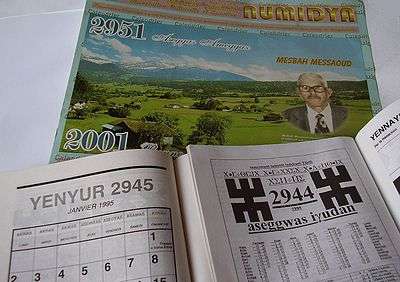Yennayer
| Yennayer | |
|---|---|
 Three Berber calendars, all of them refer to the Shoshenq era (Gregorian + 950). | |
| Official name | Aseggwas Amaziɣ |
| Also called | Amazigh New Year |
| Observed by |
|
| Type | Berber |
| Begins | 12 January |
| Ends | 13 January |
| 2017 date | 14 January |
| 2018 date | 12 January |
Yennayer is the first month of the Berber Year (Berber languages: Aseggwas Amaziɣ, ⴰⵙⴻⴳⴳⵯⴰⵙ ⴰⵎⴰⵣⵉⵗ) or the agrarian Berber year used since antiquity by the Berbers in North Africa. Its first day corresponds to the first day of January of the Julian Calendar, which is shifted thirteen days compared to the Gregorian calendar, i.e. 14 January of every year.
Probably due to a mistake of the first cultural associations asking to return to this traditional celebration, the opinion that the traditional date is 13 January is very widespread specially in Morocco, Libya and Canary Islands. Whereas in Algeria is 12 January. On 27 December 2017, Algeria's President Abdelaziz Bouteflika decided to recognize Yennayer as a public holiday celebrated on 12 January of every year.[1]
Origins
In 1968, the Berber Academy proposed to inaugurate a "Berber Era", after the Christian era and the Islamic calendar. It fixed as year one of the Berber calendar the first known manifestations of the Berber civilization, in the Ancient Egypt, when the Berber Libyan Shoshenq I (Cacnaq, founder of the 22nd Egyptian dynasty) took the throne and became a Pharaoh in ancient Egypt.
Etymology
Yennayer is the Berber form of January, cognate with Italian gennaio and Spanish enero.
The celebration and the tradition
Yennayer is a very widespread in the Berber world. It is considered as national celebration. The Berber year 2968 corresponds to 2018.
Imensi umenzu n yennayer (Dinner of the first day of January)
The meal prepared for this circumstance is hearty and different from the everyday ones. The rites are done in a symbolic manner. They aim to eliminate the famine, to augur the future and the change, and to warm welcome the invisible forces the Berber believed in.
For the preparation of " imensi n yennayer ", the Kabyle uses the meat of the sacrificed animal (asfel) to complement the couscous, fundamental element of the berber culinary art.
An opportunity to exchange wishes for prosperity
Yennayer symbolizes longevity, and it is often the occasion to include other familiar events:
- First hair cut for little boys.
- Marriage under the good omen of Yennayer.
- Agricultural initiation rites: The Berbers send their children to the farm to pick themselves fruits and vegetables.
Bibliography
- Encyclopaedia Universalis. France S.A. 1989.
- Paul Couderc. Le calendrier. P.U.F. Que sais-je. no 203
- Jean Servier. Tradition et civilisation berbères. "Les portes de l’année". Éditions du Rocher. août 1985
See also
References
- ↑ "Algeria sets Berber New Year as public holiday". Middle East Monitor. 28 December 2017. Retrieved 29 December 2017.